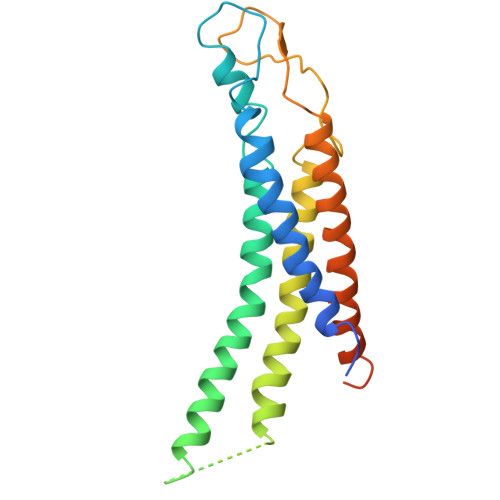Asymmetric configurations and N-terminal rearrangements in connexin26 gap junction channels.
Oshima, A., Tani, K., Toloue, M.M., Hiroaki, Y., Smock, A., Inukai, S., Cone, A., Nicholson, B.J., Sosinsky, G.E., Fujiyoshi, Y.(2011) J Mol Biol 405: 724-735
- PubMed: 21094651
- DOI: https://doi.org/10.1016/j.jmb.2010.10.032
- Primary Citation of Related Structures:
3IZ1, 3IZ2 - PubMed Abstract:
Gap junction channels are unique in that they possess multiple mechanisms for channel closure, several of which involve the N terminus as a key component in gating, and possibly assembly. Here, we present electron crystallographic structures of a mutant human connexin26 (Cx26M34A) and an N-terminal deletion of this mutant (Cx26M34Adel2-7) at 6-Å and 10-Å resolutions, respectively. The three-dimensional map of Cx26M34A was improved by data from 60° tilt images and revealed a breakdown of the hexagonal symmetry in a connexin hemichannel, particularly in the cytoplasmic domain regions at the ends of the transmembrane helices. The Cx26M34A structure contained an asymmetric density in the channel vestibule ("plug") that was decreased in the Cx26M34Adel2-7 structure, indicating that the N terminus significantly contributes to form this plug feature. Functional analysis of the Cx26M34A channels revealed that these channels are predominantly closed, with the residual electrical conductance showing normal voltage gating. N-terminal deletion mutants with and without the M34A mutation showed no electrical activity in paired Xenopus oocytes and significantly decreased dye permeability in HeLa cells. Comparing this closed structure with the recently published X-ray structure of wild-type Cx26, which is proposed to be in an open state, revealed a radial outward shift in the transmembrane helices in the closed state, presumably to accommodate the N-terminal plug occluding the pore. Because both Cx26del2-7 and Cx26M34Adel2-7 channels are closed, the N terminus appears to have a prominent role in stabilizing the open configuration.
Organizational Affiliation:
Department of Biophysics, Faculty of Science, Kyoto University, Oiwake, Kitashirakawa, Sakyo-ku, Kyoto 606-8502, Japan.














